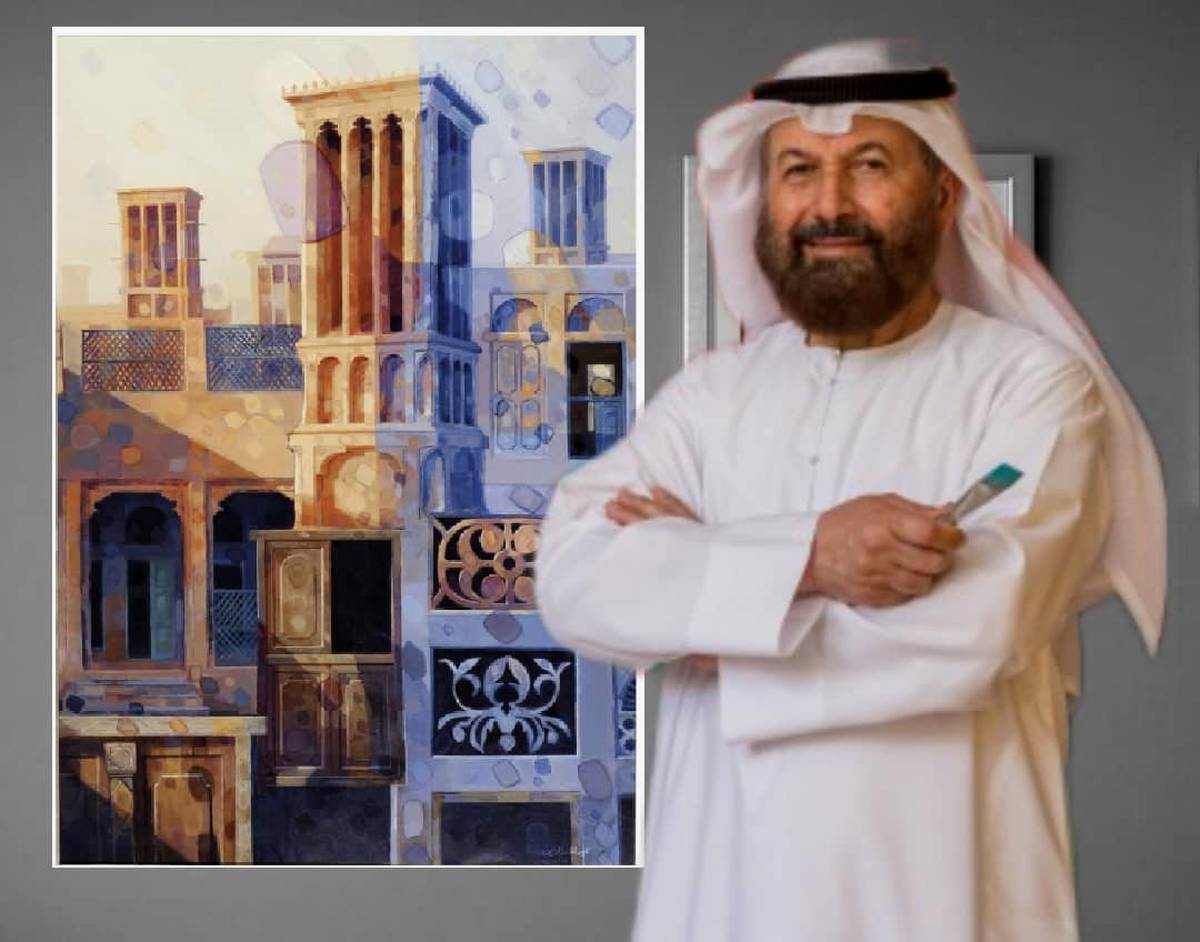
Abdul Qader Al-Rais: Light, Memory, and the Architecture of Heritage – An Analysis of a Work
Few artists embody the story of Emirati modern art as fully as Abdul Qader Al-Rais (b. 1951). Over more than five decades, he has become one of the UAE’s most recognized painter, chronicling the country’s dramatic transformation while safeguarding its cultural memory on canvas. His works range from meticulous renderings of traditional neighbourhoods to abstract explorations inspired by Arabic letterforms. The thread that connects them is his hallmark floating square motif—translucent forms that shimmer across his surfaces like particles of refracted light.
ArtDayMe: Azadeh Jafarian: One of the clearest examples of his heritage-inspired style is Untitled (from the Impressionist Collection), a monumental oil on canvas completed on 14 April 1990. Measuring 139 × 97 cm and signed in Arabic, the painting was auctioned in Christie’s International Modern and Contemporary Art auction Dubai in October 2008, fetching USD 146,500. More than a market highlight, the work distills Al-Rais’s enduring dialogue between architectural heritage, atmospheric light, and modern abstraction.
Architecture as Memory
The canvas presents a vista of traditional Emirati architecture—soaring barjeel (wind towers), intricately carved doors, arched windows, and ornate latticework. These details are not incidental; they are emblems of identity and ingenuity. In the pre-oil era, the barjeel was a vital device for natural ventilation, a vernacular solution to extreme heat. By the late 20th century, such structures were vanishing amid rapid modernization.
Al-Rais’s decision to depict them in 1990 was more than an act of nostalgia. It was a form of cultural preservation, translating fragile, disappearing architecture into timeless images. The repeating patterns and geometric ornament also resonate with Islamic visual traditions, where symmetry and order symbolize the infinite.

Composition and Atmosphere
The painting’s structure underscores this sense of permanence and transience. A central wind tower anchors the vertical composition, while flanking façades step back in rhythmic layers. The work is divided into warm and cool halves: ochres and siennas dominate the left, while violets and greys cool the right. This bipartite design suggests the passage of time, almost as if two moments of day were fused into one frame.
Suspended across the entire surface are Al-Rais’s signature floating squares. These translucent forms drift like dust in sunlight, softening the border between architecture and sky. They act as both atmosphere and abstraction, modernizing the scene and tying it into his broader body of work.
Color and Light
Light is the true protagonist of this canvas. Rather than sharp highlights, Al-Rais uses diffuse illumination to capture the hazy glow of an afternoon. His warm palette of ochres and terra-rosas evokes sunlit plaster, while ultramarines and slate tones conjure the cool of shadows. Together, these hues form a complementary balance of orange and blue, a classical harmony reimagined in local tones.
The floating squares, glazed in soft mauves and creams, intensify this impression. They give the surface a vibrancy that makes the scene feel alive, as if shimmering before the viewer’s eyes.

Technique and Material
Although renowned for his watercolors, Al-Rais’s large oils are less common and highly prized. Oil gives him the flexibility to alternate between translucent washes and dense, mosaic-like brushstrokes. Forms are built through shifting temperatures and soft edges, lending the architecture solidity while keeping its outlines dreamlike.
The floating squares are achieved through layered scumbling and glazing, allowing colors beneath to glow through. The painterly effect recalls Impressionism and Post-Impressionism, which explains why the auction house placed the work in its “Impressionist Collection.” Yet the content remains distinctly Emirati.
A Modernist from the Emirates
Al-Rais is not merely a chronicler of old neighbourhoods but a pioneer of Emirati modernism. As a founding member of the Emirates Fine Arts Society, he helped shape a national art identity that combines heritage with global modernist vocabularies. His 1990 canvas reflects this synthesis: architectural realism infused with abstract overlays, heritage viewed through a contemporary lens.

Legacy of a Canvas
Viewed today, Untitled (from the Impressionist Collection) is more than a record of vanished buildings. It is a dialogue between memory and modernity, a vision that reframes Emirati heritage within the idiom of modern art. Like much of Al-Rais’s work, it moves between hyper-real observation and lyrical abstraction, united by his floating squares.


LEAVE A RELPY